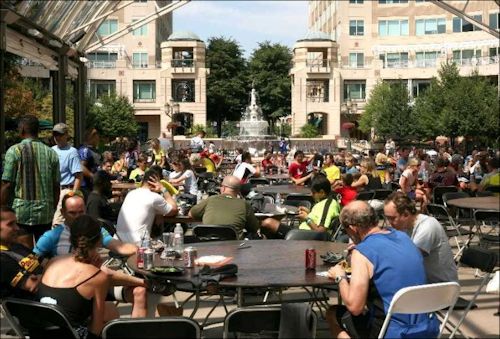
Reston Town Center got a half-century head start in creating the kind of community where enterprises want to do business in the 21st-century knowledge economy. The original developers were planning for and building walkable, mixed-use development before walkable, mixed-use development was cool. And today property owners are reaping the benefits.
According to Cushman/Wakefield, offices in Reston Town Center are near full occupancy and command among the highest rents in Northern Virginia. The business district’s big competitive advantage? A strong amenity base. Summarizes Virginia Business:
The report notes that in addition to 2.8 million square feet of office space, Reston Town Center is home to 50 retail shops, 30 restaurants and three residential high-rise projects. Even with a suburban location 20 miles outside of Washington, D.C., and a lack of Metro accessibility until at least 2018, the center’s density, mixed-uses and walkability give the center an urban feel that attracts tenants and residents.
Reston achieves high occupancy despite the fact that tenants pay a 30% rent premium to be there. The situation in Reston stands in marked contrast to the other major business centers, Tysons and the Ballston-Rosslyn corridor. Spurred by the arrival of the Metro Silver Line, Tysons is desperately trying to reinvent itself from a case study in suburban sprawl into a paragon of Transit Oriented Development. But the transition to a coherent, walkable place will take place over years, if not decades. Property owners in Arlington’s Ballston-Rosslyn corridor have Reston-style amenities and have been demanding Reston-style rents but have been afflicted by the departure of large government tenants.
Bacon’s bottom line: Could the marketplace be speaking any more clearly? People are demanding walkable urbanism. It doesn’t have to be located in the core of the metropolitan area. It doesn’t even have to have Metro service. People like compact, walkable, mixed-use development. Developers who deliver that product will make money. Localities that foster its development will see their tax base grow.
— JAB


